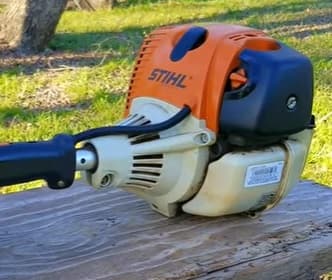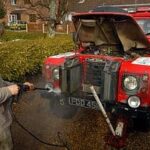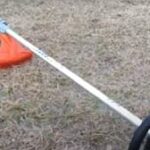As an Amazon Associate, this site earns commissions from qualifying purchases. For more information click here.
Stihl string trimmers are versatile tools that make gardening easier. Machines being machines however, there might be times when your Stihl trimmer won’t start. Here are the reasons why it happens and the solutions.
Stihl string trimmers may refuse to start if the carburetor is flooded or the air filter is clogged. A dirty fuel filter or incorrect fuel mixture can also prevent the engine from turning.
Dirty Air Filter
Combustion engines need air to ignite the fuel, which make air filters essential. The filter also screens out debris so they do not contaminate the fuel.
Air filters have to be cleaned or replaced so dirt does not build up. Air cannot pass through a clogged filter, and without air engine combustion is impossible.
How to fix it. You have to clean or replace the air filter. Usually they are located under the rear engine cover. Remove the cover screws and take out the filter.
- Air filters should be replaced after every 25 hours of use. You should also replace it if there is too much dirt or it has tears.
- To clean an air filter, brush off the dirt. Remove as much as you can.
- Mix mild soap or detergent with warm water in a container. Place the filter in it for a few minutes.
- Take the filter out of the soapy mix. Gently squeeze it to remove excess water.
- Dispose of the mixture and rinse the filter under running water. Let the filter dry before putting it back on the weed eater.
Dirty Spark Arrestor
A spark arrestor is designed to catch engine sparks to prevent any potential fire. It also prevents debris and dirt from reaching the engine.
Over time, spark arrestors get clogged with dirt. Air can no longer pass through and the dirt causes the internal temperature to increase.
How to fix it. The solution is to clean the spark arrestor. First you have to remove the muffler cover. You will see the spark arrestor held in place by screws.
Use a screwdriver to remove the screws and hold the spark arrestor up with a pair of needle nose pliers. Wipe it clean with a cloth.
If that does not work, take the spark arrestor outdoors and use a blowtorch to clear it up. Be careful when handling the blowtorch and take all precautions.
Wait until the spark arrestor is cool to touch before putting it back in the weed eater.
Fuel Issues
There are three potential problems that can arise:
- Wrong fuel mix ratio
- Fuel is too old
- Too much gas
How to fix it. What you do depends on what the fuel issue is. Let’s take a look at each one.
Wrong fuel ratio. Majority of string trimmers are on 2-stroke engines. These usually require a 40:1 mix of gas and oil. Sometimes they run on 32:1 or 50:1 so check your owner’s manual.
An incorrect fuel ratio will cause engine problems and prevent the engine from starting. If you suspect this is the cause, discard the fuel and pour a new mix.
Old fuel. String trimmer fuel has to be replaced every 30 days with a fresh mix. If you leave fuel for more than 30 days, residue will start to build up.
Fuel residue becomes an even bigger problem if the trimmer isn’t used much. What happens is the gas dissipates and leaves sludge behind, clogging the carburetor and leaving a mess.
You can avoid this by regularly replacing the fuel and using the trimmer. Empty the fuel tank if you won’t be using the trimmer for several weeks. Or you can put Stabil fuel stabilizer in the tank.
Too much gas. Too much gasoline can flood the engine. You can tell because the trimmer smells like gas when you turn it on and smoke may come out of it.
The most common fix is to let the engine run until the extra fuel is used up. If the engine won’t start, turn off the choke and pull the cord while holding the throttle down.
Spark Plug Not Working
Spark plugs provide the spark required for combustion, so it’s an essential part of the engine. There are many reasons why a spark plug can stop working, but regardless of the cause, it’s going to stop Stihl string trimmers from working.
A faulty spark plug can also cause engines to overheat. Check out my guide on what to do if your weed eater overheats.
How to fix it. There are many reasons why a spark plug can fail. Wear and tear, oil residue, physical damage etc. To find out what’s wrong, look for the boot (the black wire connector) then pull out the spark plug.
At this point you have two options: clean or replace the spark plug. I recommend replacing spark plugs since they’re inexpensive.
You can easily clean spark plugs, but if it’s had 20+ hours of use, it’s going to wear out soon.
My suggestion is this:
- Replace the spark plug after 25 hours of use.
- If you suspect there’s a problem, inspect the spark plug. If there are cracks, warping etc. replace it.
The only time I would recommend cleaning is if the spark plug is still new or there is only light soot.

Flooded Carburetor
Stihl trimmers are going to stall if the carburetor is flooded. There are many reasons why this happens, but often it’s because the fuel is old or there is too much of it.
How to fix it. Fortunately there are many ways to un-flood a carburetor. This should work for almost Stihl string trimmers and even other brands.
Burn the excess fuel off. If the engine can start, just let it run for at least 15 minutes. This is going to burn the gas and the engine should resume its normal function.
Keep pulling. Stihl trimmers only take a couple of pulls to start. If the carburetor is flooded it might require more. Pull 3-4 times until the engine cranks.
Adjust the choke. If the two methods above do not work, turn the choke. Pull the cord multiple times while you hold the throttle down.
Clogged Carburetor
If the carburetor is clogged with oil residue and debris, your Stihl string trimmer will not run. Chances are a flooded carburetor is also a dirty one, so you may want to clean it first before doing any repair.
How to fix it. Use Gumout as it does an excellent job of cleaning string trimmer carburetors. Follow the product instructions and once cleaned, the carburetor should start working again.
To clean a carburetor, you have to remove it from the trimmer. Usually the carburetor is located under the air filter, so you have to remove that first.
Seized Engine
String trimmer engines are going to seize if any of the following is missing: fuel, oxygen or heat. If all three are present but you’re still facing problems, here are the solutions.
How to fix it. A seized engine has many possible causes, so we need to diagnose the potential issues.
- Not enough oil or gas. You have to replace the fuel with the proper mixture.
- Not enough airflow. Fuel needs air to combust. The air filter and spark arrestor may need cleanup or replacement.
- Faulty spark plug. Replace the spark plug.
Clogged Fuel Filter
The fuel filter protects the engine from debris. It is a critical part of the system and is required for Stihl trimmers to operate.
Because the filter traps the debris, it accumulates a lot of dirt over time. A dirty fuel filter can no longer function and can make things worse by clogging the system.
How to fix it. You can either clean or replace the fuel filter. I prefer to replace the fuel filter for the following reasons.
Fuel filters are inexpensive. You can buy a few as reserve and if the current filter no longer works, replace it with a new one.
Second, it takes a lot of soot and dirt for a fuel filter to stop working. If it reaches that point, the filter is no longer worth cleaning and you’re better off replacing it.
To replace a fuel filter, follow these steps.
- Remove the air filter.
- Drain the fuel.
- Remove the fuel cap. You will need a screwdriver.
- Get a wire and bend it into a hook.
- Insert the wire into the fuel tank. Retrieve the fuel line that holds the fuel filter.
- Pull the fuel filter off the fuel line.
- Take off the fuel line clip.
- Place the fuel clip 1/4 of an inch at the end of the fuel tube.
- Put your new fuel filter onto the tube.
- Place the filter back onto the fuel tank.
- Put the fuel cap back on.
- Put the air filter back.
There are quite a few steps needed to take out a fuel filter. If you are going to go through this, might as well put in a new fuel filter.

I love the outdoors and all the tools for maintaining gardens, yards and lawns. The only thing I am more passionate about is sharing what I know about garden and outdoor equipment.


